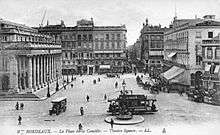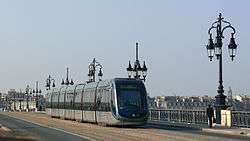Bordeaux tramway
 | |||
| Overview | |||
|---|---|---|---|
| Native name | Tramway de Bordeaux | ||
| Locale | Bordeaux, Aquitaine, France | ||
| Transit type | Light rail tram | ||
| Number of lines |
3[1] (1 under construction) | ||
| Number of stations | 90[1] | ||
| Daily ridership | 165,000 (2009) | ||
| Website | InfoTBC (English) | ||
| Operation | |||
| Began operation | 2003 | ||
| Operator(s) | TBC | ||
| Number of vehicles | 74[1] | ||
| Technical | |||
| System length | 43.9 km (27.3 mi)[1] | ||
| Track gauge | 1,435 mm (4 ft 8 1⁄2 in) standard gauge | ||
| Electrification |
750 V DC ground-level power supply (APS) (city centre) 750 V DC overhead line (outside city centre) | ||
| |||
The Bordeaux tramway network (French: Tramway de Bordeaux) consists of three lines serving the city of Bordeaux in Aquitaine in southwestern France.
The first line of Bordeaux's modern tramway opened on 21 December 2003; further extensions have increased the route length to 43.9 kilometres (27.3 mi).[1] The system is notable for using a ground-level power supply of the Alimentation par Sol (APS) system in the city centre. It has been operated by Keolis Bordeaux since 1 May 2009.
History
Original tramway

The first tramway line of Bordeaux, with cars towed by horses, dates back to 1880. In 1946, the public transportation system in Bordeaux had 38 tram lines with a total length of 200 kilometres (120 mi), carrying 160,000 passengers per day. A rudimentary system of ground-level power supply was used on some stretches with mixed success. As in other French cities at the time the mayor, Jacques Chaban-Delmas (first elected in 1947), embraced anti-tram arguments and decided to terminate the operation of the tramway. He found the tramway to be old-fashioned compared to the bus and its attachment to set tracks on the ground hindered the increasing flow of cars. The lines were closed one after the other. In 1958 the last line of tramway was terminated.
Other
By the 1970s the failure of the "all car" transport policy had become obvious, but Chaban was not prepared to backtrack. A grandiose automatic light underground railway (VAL) scheme was promoted; it even received the backing of a majority of the city's councillors, but fell victim in the end not just to the fierce opposition of the local transport users' association TRANSCUB but to the hard reality of the fine sandy nature of the city's soil. The VAL idea was dropped. Chaban remained.
Bordeaux had to wait until 1995 and the election of Alain Juppé as mayor – as well as the total strangulation of the city by its transport problems – before the situation was tackled. Following two years of studies, the Bordeaux Urban Community adopted the tramway plan in 1997. Recognized by the central government in 2000 as a Public Interest Project, the scheme got under way and by 21 December 2003 was carrying passengers on three routes, one of which was extended on 25 September 2005, with further extensions opened in 2007 and 2008.
Operations
| TBC |
|---|
 |
| Tramway |
| Bus |
A particular feature of the new Bordeaux tram network is its ground-level power supply system which is used in the city centre to avoid overhead wires spoiling the view of buildings. This was the source of many difficulties and breakdowns when first introduced. Improvements since then, however, have increased reliability and the network is now one of Bordeaux's principal plus points, valued not just for enabling the people of the city to get about easily but also for its contribution to the aesthetics of the city and its quality of life. The new trams are an essential part of Bordeaux's current tourist redynamization strategy. The three lines were extended in 2007 and 2008 to reach several housing estates as well as the suburb of Mérignac. The whole system is under video surveillance, with a camera installed inside each vehicle.
Hours of operation and headways
Trams operate on all lines from around 4.30am until midnight, seven days a week with later service on Thursdays, Fridays and Saturdays until around 1.30am. All stops have panels showing the waiting time until the next tram. On Sunday and holiday mornings, trams run every 30/40 minutes until around 1000am then every 20 minutes. Weekday and Saturday services operate every 10 – 12 minutes with additional service during 'rush hour' and for special events. However, there is no service at all on May 1, Labour Day holiday.
The network
As of July 2009, the Bordeaux tram network has a total route length of 43.9 kilometres (27.3 mi),[1] with 90 stops.[1][2]
The current routes of the three lines are:
| Line | Length[1] | Stations[1][2] | Route |
|---|---|---|---|
| A | 20.6 km (12.8 mi) | 41 | Mérignac Centre - La Gardette Bassens Carbon Blanc and Floriac Dravemont |
| B | 15.2 km (9.4 mi) | 32 | Pessac Centre (via the University campus) - Berges de la Garonne |
| C | 8.1 km (5.0 mi) | 17 | Terres Neuves (via Gare de Bordeaux-Saint-Jean) - Berges du Lac |
The first line (Line A) was opened on 21 December 2003 in the presence of President Jacques Chirac, and the mayor of Bordeaux, Alain Juppé. It ran between Mériadeck and Lormont/Cenon. It was extended on 26 September 2005 to new termini at the Pellegrin Hospital and Saint-Augustin. Further extensions opened in 2007; from Cenon to Floriac on 27 February 2007; and from Saint-Augustin to Mérignac Centre on 21 June 2007. A new extension from Lormont Lauriers to Carbon Blanc opened in May 2008.
Line C was the next to open between Quinconces and Gare St Jean, on 24 April 2004, following delays. The first part of the southern extension from Gare St. Jean to Terres Neuves was opened in February 2008, as was the northern section to Les Aubiers. From there via Berges du Lac (February 2014) to the final terminus at Parc Des Expositions in the Bordeaux Lac commercial and exhibition district it went into service in January 2015. This was followed in mid-March 2015 by the southwards extension to Lycée V. Havel (Villenave-d'Ornon).
Line B was partially opened on 15 May 2004 and throughout on 3 July 2004. 29 May 2007 saw the opening of the first phase of its 2007 extension of when it began to serve Pessac Centre at its western end. On 23 July 2007 a further extension of the line from its previous terminus at Quinconces, along the left bank of the Garonne, to a station at Bassins à Flot opened. The final extension to northern terminus of the line at Cité Claveau, near to the Pont d'Aquitaine on the Bordeaux ring road, opened in October 2008.
The main depot for trams is at Thiers Benauge (off Line A) and a secondary depot has opened on Line B at Rue Achard on the new extension towards Claveau.
Traffic
The overall system (tram and bus) recorded 117 million passenger journeys in 2012.
Electric power / Ground-level power supply

By demand of the Municipality of Bordeaux (CUB), part of the system uses ground-level power supply (APS). There is no overhead wire, and electric power to the tram is supplied by a center rail with only the portion directly under the tram electrically live. This prevents electrocution of pedestrians and animals. See the adjacent photograph.
Rolling stock

As of June 2008 the fleet is composed of 74 type 300[3] Citadis trams constructed by Alstom:
- 62 Citadis 402 — length: 43.9 m, width: 2.4 m, weight: 54.9 tons. 7 segments with 4 bogies and 3 motors and 720 kW power. These trams can transport from 230 (at 4 passengers per m²) to 345 (at 6 passengers per m²) with 70 sitting. These trams are used on lines A and B.
- 12 Citadis 302 — length: 32.8 m, width: 2.4 m, weight: 41.3 tons. 5 segments with 3 bogies and 2 motors and 480 kW power. These trams transport a maximum of 265 passengers with 48 seated. These trams are used on Line C.
All trams are air conditioned and have a low floor. The rails are standard gauge (1,435 mm (4 ft 8 1⁄2 in)) and power is 750 V DC. The maximum speed is 60 km/h with an acceleration of 1.15 m/s². The deceleration obtained from emergency braking is 2.85 m/s².
On 6 January 2016, Bordeaux Metropole ordered 10 further Citadis 402 trams from Alstom, at a cost of €28m, thus bringing the total number of Citadis trams that the city has ordered since 2000 to 115. The trams are due to enter service in 2018, and are identical to those currently used on lines A and B.[4]
Incidents
The tram derailed once, in December 2011, without casualties.[5]
Planned extensions and projects
A 'tram-train' project is also under way.[6] This 7.2 kilometres (4.5 mi) line[6] will be a branch from existing Line C, turning off after the stop Cracovie. It will join the route of the former Médoc line at La Vache then run parallel to it as far as Blanquefort, via several stations including the existing SNCF stop at Bruges. This new line is expected to be in service at the end of 2017.[6]
A new Line D tramway is in the planning stages.[7] This new 9.8 kilometres (6.1 mi) line will travel northwest from Bordeaux through Le Bouscat, Bruges and Eysines, ending in Le Haillan.[7] Construction on this new Line D is expected begin in 2015, and it is projected to be in service by 2017.[7]
See also
- TBC
- Lines A, B, and C
- Transportation in Bordeaux
- Trams in France
- List of town tramway systems in France
References
- 1 2 3 4 5 6 7 8 9 "Chiffres" [Figures]. LaCUB.fr (in French). Retrieved 2013-10-18.
- 1 2 "Plan Touristique Tbc" [Tourist Map TBC] (PDF) (in French). TBC. January 2013. Retrieved 2013-10-18.
- ↑ Revue Connaissances du Rail : Trams de France 2007
- ↑ "Bordeaux orders 10 more Citadis trams". railwaygazette.com. 6 January 2016. Retrieved 7 January 2016.
- ↑ http://www.letudiantbordelais.fr/2011/12/recit-photos-un-tramway-deraille-place.html
- 1 2 3 "Tram train du Médoc" [Tram train of Medoc]. LaCUB.fr (in French). Retrieved 2013-10-18.
- 1 2 3 "La ligne D est une nouvelle ligne de 9,8 km au Nord-Ouest de l'agglomération, qui s'étendra sur les communes de Bordeaux, Le Bouscat, Bruges et Eysines." [Line D is a 9.8 km new line for northwest of the town, which will run to the towns of Bordeaux, Le Bouscat, Bruges and Eysines.]. LaCUB.fr (in French). Retrieved 2013-10-18.
External links
| Wikimedia Commons has media related to Bordeaux tramway. |
- InfoTBC - TBC official website (French)
- InfoTBC - TBC official website (English)
- Plan Touristique Tbc - tramway and bus network map (pdf) (French)
- La CUB (La Communauté Urbaine de Bordeaux) tram - travaux extensions créations (French)
